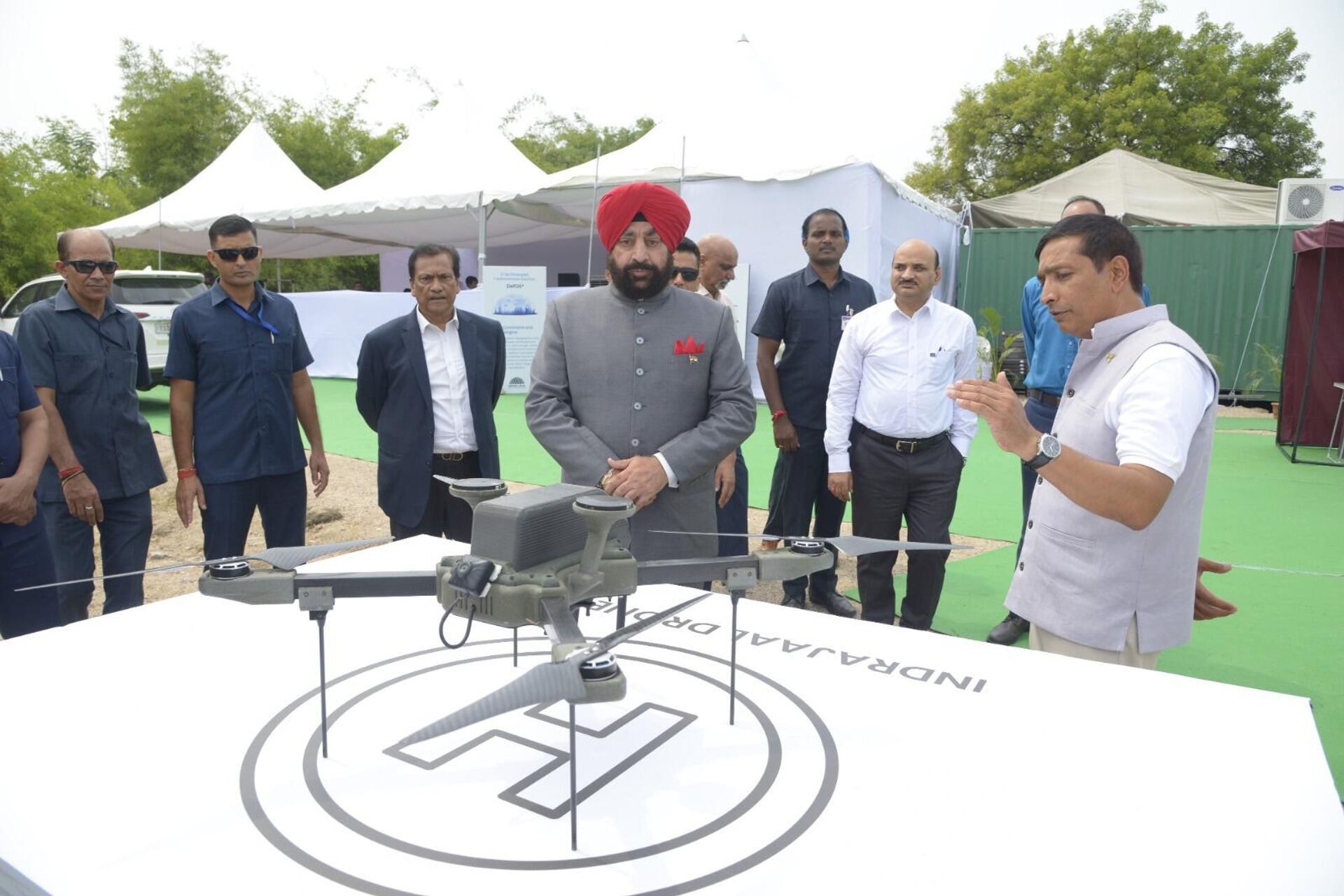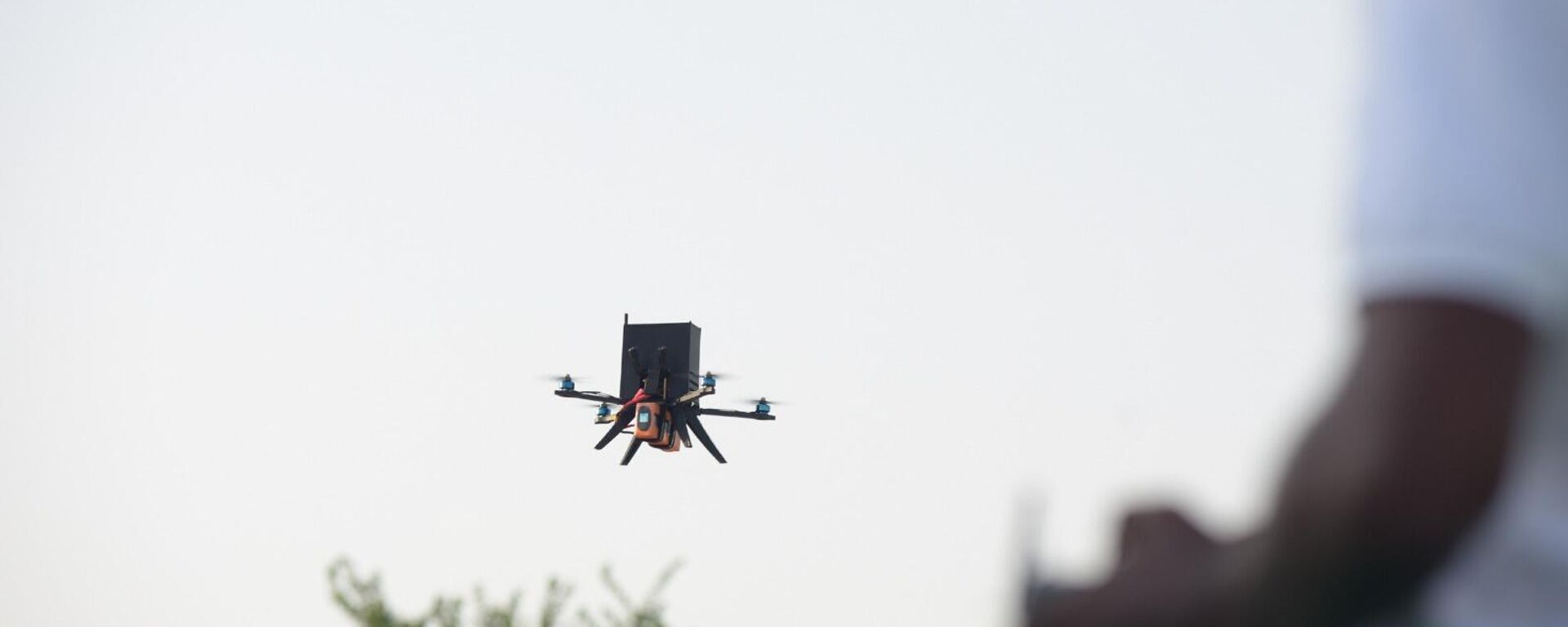Special: How Does India’s First AI-Powered Anti-Drone System Counter Drone Attacks?
17:57 06.09.2023 (Updated: 15:36 07.09.2023)

© Twitter/@LtGenGurmit
Subscribe
The Indian government has set a target of achieving a $1 billion drone industry by 2025 and has taken various measures to support sectors like agriculture, defense, and logistics. However, there has also been a sudden rise in drone attacks at India's borders and across countries.
Drones, unmanned aerial vehicles (UAVs), or unmanned aircraft systems, are revolutionizing the nature of modern warfare by introducing new threats and tactics.
From drone attacks at prime locations such as borders, refineries, oil installations, and large events to smuggling drugs, the use of drones for illicit activities is on the rise across the globe.
To counter such challenges, Retired Wing Commander Mallela Venkata Narashimha (MVN) Sai, Director of Grene Robotics, has co-founded Indrajaal, India’s first AI-powered anti-drone system.
MVN Sai talks to Sputnik India about how he brought his 30 years of experience in the Indian armed forces and 10 years of research with his team to build an AI-powered anti-drone system - Indrajaal.

Indrajaal: India's First AI-Powered Anti-Drone System Unveiled
© Photo : Grene Robotics
Sputnik India: What is the reason behind the rise in the demand for drones across various sectors over the past 10 years?
Sai: Drones are being increasingly adopted not just for photography purposes but also in sectors like agriculture, defense, logistics, and at big events like the Olympics at a large congregation of political leadership.
There's a huge proliferation of the technology. But that has a flip side to it as well since drones can be utilized for malafide intentions and pose a great threat.
The borders are definitely one of the most porous. Drones can be used for narcotics smuggling and inflict more serious damage on the border, attacks on refineries, oil installations, nuclear installations, dockyards, and others.
Swarm drones are a bigger threat. We've also seen a lot of drone attacks happening in the peninsula desert region as well as at political establishments like in Russia and at the White House in the U.S.
Considering that these could be the targets, we need a singular system that has the control to defend and protect from them.
Hence, we have launched India’s First AI-Powered Anti-Drone System - Indrajaal that can be customized as per the need and job required and could be deployed to safeguard a small area of two km, or a 400 km oil refinery or a 4000 km border segment.
Sputnik India: Tell us about India’s first AI-Powered anti-drone system - Indrajaal?
Sai: Indrajaal is a network-centric system that includes sensors, weapons, and a control system.
Indrajaal system fulfills the demand of the entire Indian airspace where there's a huge need for counter-drone systems, including large borders.
Since we can't deploy hundreds of anti-drone systems to protect the border, we need to unify segments of the border and keep them under a singular command control and Indrajaal serves the purpose.
© Sputnik
Sputnik India: What was the idea behind coming up with Indrajaal system?
Sai: In response to an autonomous battle, you need an autonomous system. You need the system to be pervasive and cover a significantly wide area.
So, the motivation for us was to tackle the modern threat that has been changing and understand various technical nuances as to how things are moving in the modern battle space.
We have poured those learnings into our architecture, which has taken approximately 10 years of work.
Last year, specifically, we came up with the idea for the Indrajaal system, and now we have reached a point where it is ready. We have conducted a series of demonstrations in the last week to various paramilitary and armed forces and industry leaders. And here we are, ready to deploy the technology.
Sputnik India: What is the USP of Indrajaal system?
Sai: We are one of the first ones to bring a mesh wide area network (WAN) centric approach to Counter Unmanned Aircraft System (C-UAS).
They are fully autonomous which has been achieved through AI (Artificial Intelligence).
It facilitates net-centric operations, which means the entire segment under control can be commanded from a single location. The series of integrations have been built into it to ensure that we have the ability to deploy it in other scenarios.
We also are a full system integrator for the entire weapons suite.
Sputnik India: How does Indrajaal system work?
Sai: The sensor set detects the threat, and AI algorithms help in tracking, identifying, and validating whether the drone is friendly or a threat.
It then engages the drone with hammers, precursors, and spoofers that can deceive the drone and make it land where you want it to land and capture it.
In the case of the military and the paramilitary, the system accesses the type of weapon that can be employed against it including surface-to-air missiles for larger and more significant intrusions of drones and other targets.
It can be deployed and can cover an entire area of up to 4,000 square kilometers.
While the sensors and the weapons including the counter drones would be deployed out in the field where it is intended to be used as a weapon, the command center would be far away from the battle space at a safer place.
The mesh connectivity of the system allows us to connect to every element and bring data in real time.
While the sensors and the weapons including the counter drones would be deployed out in the field where it is intended to be used as a weapon, the command center would be far away from the battle space at a safer place.
The mesh connectivity of the system allows us to connect to every element and bring data in real time.
Sputnik India: Do you manufacture the drones as well or collaborate with the drone companies to source them?
Sai: We do both. We do manufacture drones ourselves to mimic various kinds of targets.
You will have to create a lot of drone signatures (command and server) both electronically and physically for the radars. So we get a lot of drones manufactured from our ecosystem partners. We also built a few drones of our own for all testing purposes.
As regards the counter-drone systems, we have good partnerships with Indian companies that are also truly local.
We give the design specifications and ensure that the software is written by us in a manner that is not just dependent on the navigation stack that comes from the drone but also controls' software.
Sputnik India: The biggest challenge with drones is battery running down. How did you tackle that?
Sai: The counter-drone has a very high level of technology readiness and is essentially fully autonomous in nature. This means it will take off and land on its own. Hence, it will recharge once it's on the station.
We will probably deploy them for months; they'll sit on their battery packs ready to take off on an instruction.
The system is completely autonomous instructions for take-off. It also gives instructions to return home and land autonomously, so that will solve the problem of limited battery life.
We will probably deploy them for months; they'll sit on their battery packs ready to take off on an instruction.
The system is completely autonomous instructions for take-off. It also gives instructions to return home and land autonomously, so that will solve the problem of limited battery life.
The weapon systems too are autonomous and placed in a position that is connected to the power sources.
Sputnik India: Would you be selling the Indrajaal system to other countries?
Sai: Yes, we are open to collaborating with other countries for the deployment of the system.
Apart from India’s paramilitary and armed forces, we have been getting inquiries from other countries for the Indrajaal system.
Sputnik India: What are the upcoming plans now?
Sai: We are ready to deploy Indrajaal and produce the system in large numbers.
We're waiting for confirmed orders and reaching out to governmental, private, and public sector, industry partners, as well as paramilitary and military officials. Soon it'll be adopted very quickly.
The next six months are going to be crucial for ensuring that the technology reaches the real deployments.
We're waiting for confirmed orders and reaching out to governmental, private, and public sector, industry partners, as well as paramilitary and military officials. Soon it'll be adopted very quickly.
The next six months are going to be crucial for ensuring that the technology reaches the real deployments.
Sputnik India: What are the other technologies your team has created?
Sai: Over the last 10 years, we've done significant work in surface-to-air missile control.
We've also built several algorithms and applications in electronic warfare, airspace management, air traffic management, and many others.
In the military space, we have developed radars, electro-optic sensors, vibration sensors, acoustic sensors, underground sensors, discreet sensors, and others.
We have also implemented surface-to-air missile systems to counter faster-moving aircraft and integrated radars capable of detecting human beings, small boats, and other potential threats.
We have also worked on forest surveillance and developed a comprehensive framework to detect and prevent animal crossings on railway tracks. Our system alerts trains to avoid collisions with wildlife, ensuring the safety of both animals and railway operations.
We have also worked on forest surveillance and developed a comprehensive framework to detect and prevent animal crossings on railway tracks. Our system alerts trains to avoid collisions with wildlife, ensuring the safety of both animals and railway operations.


